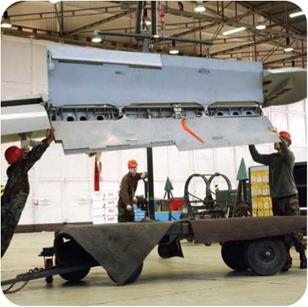Using the Rudder
When an object tries to move through air, the air pushes back. This resistance to motion is called drag. All aircraft experience drag as they move through air. When an airplane turns, the rising wing experiences more drag than the falling wing. The extra drag is caused by
|
|
SPECIAL AILERONS
Light aircraft and planes with long wings, such as gliders, suffer from the worst adverse yaw. Designers can make adverse yaw less of a problem by using special ailerons.
One type, called a Frise aileron, creates more drag when it tilts up than when it tilts down. When a plane with Frise ailerons turns, both wings create extra drag, and so there is little or no adverse yaw.
Another way to deal with the problem is to make the aileron in one wing tilt down just a little, while the aileron in the other wing tilts up a lot. These ailerons are known as differential ailerons. The rising wing creates less drag because the aileron is not tilted downward as much. As a result, the yaw problem is reduced.
The Tiger Moth biplane had differential ailerons. More modern light aircraft, such as the Cessna 152, also use differential ailerons.
_____________________________________________ /
the downward-tilted aileron. This force, called aileron drag, acts like a brake, slowing down one side of the plane. It turns the plane’s nose in the wrong direction-the opposite direction to the turn. This effect is called adverse yaw. Yaw means turning to the left or right.
An airplane’s rudder is used to control yaw. The rudder swivels to the left or right. A pilot corrects adverse yaw by turning the rudder to point the plane’s nose in the correct direction. If a plane banks to the right in order to turn right, for example, its nose yaws to the left. Adding some right rudder corrects this.
|
О Two technicians guide an aileron into place on a wing during maintenance work on an aircraft. |
N
SEE ALSO:
• Aerodynamics • Biplane • Lift and Drag • Pitch, Roll, and Yaw • Tail
• Wing











